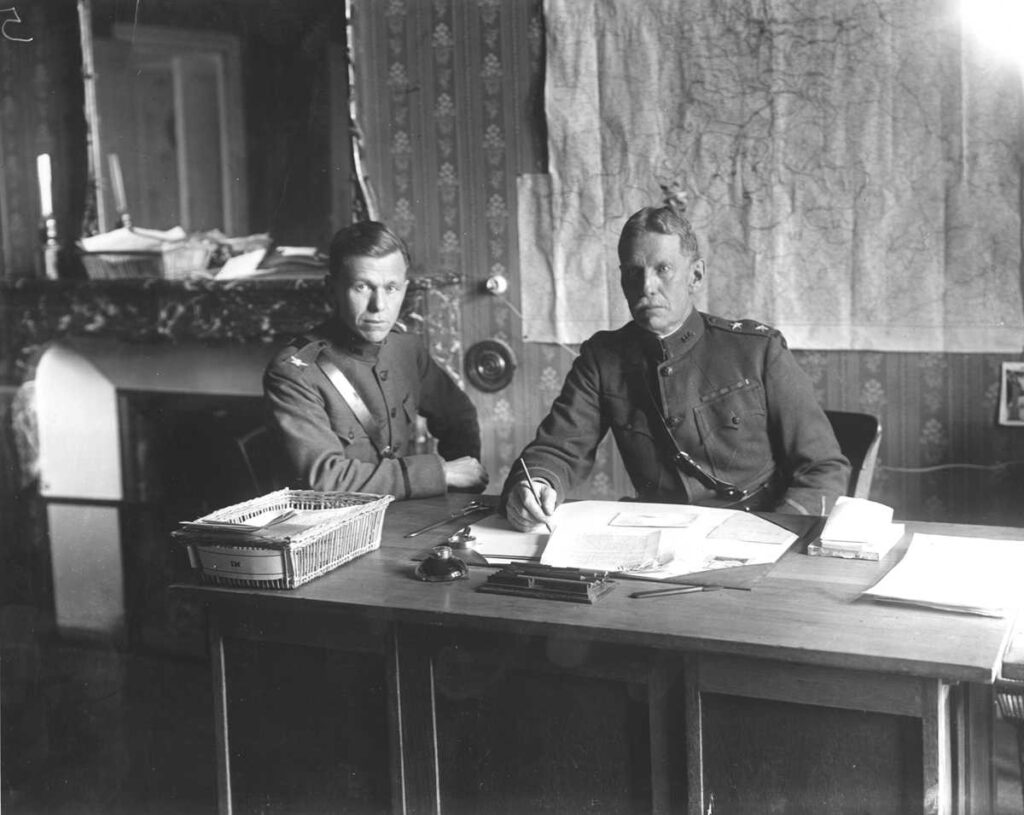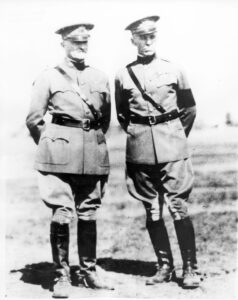George C. Marshall: Global Commander
by Dr. Forrest C. Pogue
This article is adapted from the Harmon Memorial Lecture delivered by Forrest C. Pogue in 1968, during his tenure as director of the Marshall Foundation Research Library. It previously appeared in the Fall 2017 issue of Marshall Magazine.
Clearly, General George C. Marshall was the first American general to be truly a global commander. As [U.S. Army] Chief of Staff, he commanded ground and air forces which at the end of the war in Europe numbered some 8 and 1/3 million men in nine theaters scattered around the world.
Table of Contents
The Global Reach of American Command
At the time of Pearl Harbor, Marshall’s only important garrisons outside the continental United States were in the Philippines and Hawaii. A few months later, he had troops moving to the Hawaiian Command, now commanded by airman Lt. Gen. Delos Emmons, for support of operations in the Pacific. Marshall had appointed Gen. Douglas MacArthur as commander of the Southwest Pacific Theater and arranged for him to be named as commander of the Australian forces as well. To head Army and Army Air Forces in the South Pacific, he named Gen. “Hap” Arnold’s Chief of the Air Staff, Maj. Gen. Millard F. Harmon, brother of the distinguished general for whom this series of lectures is named. Air units and service troops were also on their way to India, Burma, and China, where Gen. Joseph Stilwell was to command. An air force was also set up in the Middle East.
One morning in 1944, General Marshall invited the representative of a commander who believed that his theater was being neglected to attend a morning briefing in his office. In accordance with the usual custom, the officers charged with this duty had placed on the map the pins showing the progress on the different active fronts of the world. At a glance one could see that fighting was raging in Italy, in northwest and southern France, on the Ledo Road, in the air against Germany and the possessions of Japan, or in the widely scattered islands of the Pacific. The Chief of Staff was amused as he saw his visitor’s growing realization of the many fronts the War Department had to arm and supply.
In addition to his normal duties as Army Chief, Marshall had important special responsibilities. In 1941, he became the only military member of the high policy committee dealing with the atomic bomb project. Later, when implementation of the project was placed under Maj. Gen. Leslie Groves, that officer was made directly responsible to Secretary of War Stimson and to General Marshall.
General Marshall served as the executive of the Combined Chiefs of Staff in giving directives to Gen. Eisenhower while he was Allied Commander in the Mediterranean and, later, when he became Supreme Allied Commander in northwest Europe. He also represented the Joint Chiefs of Staff in dealing with General MacArthur in the Southwest Pacific and General Joseph Stilwell in the China Burma-India Theater.
Mobilizing a Nation for War
No other Chief of Staff in Great Britain or the United States carried a heavier burden in dealing with legislative bodies, the Press, state executives, and makers of public opinion. In frequent appearances on Capitol Hill, he gained votes for appropriations and for huge increases in manpower. His support helped to pass the first selective service legislation, after it had been brought forward by civilian leaders and bipartisan groups in Congress. In 1941, it was his strong appeal to a handful of members of the Lower House that secured the margin of one vote in the House of Representatives for the extension of the draft four months before Pearl Harbor.
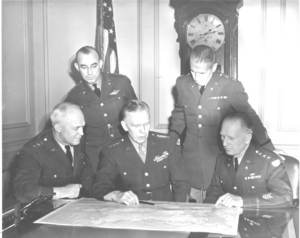
General Marshall with Chiefs of the War Department in March 1942: LTG Henry H. Arnold (seated left) and LTG Lesley J. McNair (seated right) with MG Joseph T. McNarney (standing left) and MG Brehon Somervell
Marshall found that his task did not end with obtaining appropriations and the men he needed. Early in his term as Chief of Staff he discovered that business leaders were distant to White House demands for increased war production and suspicious of Mr. Roosevelt’s proposals. Using the same frank approach to the Business Advisory Council that he had used to Congress, he gained greater business cooperation in meeting the Army’s needs.
This tremendous spreading of his time and energies was not to his liking. He had written an old friend soon after becoming Chief of Staff, “I wish above everything that I could feel that my time was to be occupied in sound development work rather than in meeting the emergencies of a great catastrophe.” But he was to spend his long term of slightly more than six years as Chief of Staff in struggling to prepare the Army and Army Air Forces for their duties in a global war. Sworn in a few hours after Hitler’s army invaded Poland, he remained at his post until the war was finished and demobilization had begun. With the exception of Marshal Stalin and the Japanese emperor, Marshall was the only wartime leader to retain the same position for this entire period. (Arnold, while chief of the Air Corps in September 1938, did not become Commanding General of the Army Air Forces and a member of the Joint Chiefs of Staff until 1942.)
At the war’s close, the British Chiefs of Staff, Field Marshal Lord Alanbrooke, Admiral of the Fleet Lord Cunningham of Hyndhope, and Marshal of the Royal Air Force Lord Portal, who had served with Marshall during much of the conflict, hailed him as “architect and builder of the finest and most powerful Army in American history.” Prime Minister Winston Churchill spoke of him as “the organizer of victory.” Marshall’s old friend, Bernard Baruch, called him the first global strategist.
Learning to Lead
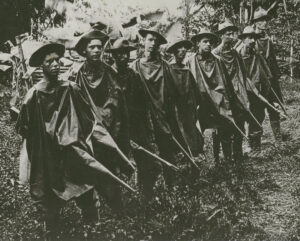
US soldiers in rain gear and guns in the Philippines, 1898. Marshall’s world view began to broaden during his first assignment in the Philippines in 1902-03.
What were the roads he followed to reach this end? In his first tour in the Philippines, Marshall gained his initial ideas of America’s global responsibilities. At the same time he struggled through the necessarily painful process of learning how to command. The Philippine Insurrection had just ended and the volunteer officers who had served in the recent war and the ensuing fighting in the Islands were going home. As a result of the shortage of Regular Army officers, Marshall found himself a few months after arrival as the only officer in charge of a company in the southern half of the island of Mindoro. With little training to guide him, with no manual on how to deal with occupied territory, cut off from the outside world except for the monthly visit of a small supply boat, he fell back on what “the Corps, the [Virginia Military] Institute, expected of a cadet officer in the performance of his duty.” He was green in military affairs, but he got by, as he recalled, with “the super-confidence of a recent cadet officer” and the help of two seasoned sergeants.
The young officer, returned to the United States after 18 months in the Islands, could never again take a wholly narrow view of the world. Although he would not return to foreign duty for more than a decade, he knew that American interests lay beyond restricted boundaries. Indeed, his career was to parallel almost exactly the first 50 years of the twentieth century as the tasks of the United States Army grew and as the United States expanded its global role.
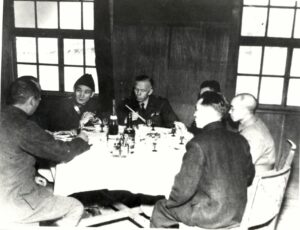
Marshall served as executive officer with the Fifteenth Infantry Regiment in Tientsin, China from Sept. 1924 through May 1927.
Growing Japanese aggressiveness worried the small Army force in the Philippines during Marshall’s second tour. He and his colleagues became involved in exercises designed to test the ability of an unnamed enemy to overrun the Islands. In 1914, the sudden illness of the officer charged with acting as chief of staff of the “enemy” landing force in southern Luzon gave Lt. Marshall his big chance to show his ability as a staff officer. Stepping into a role for which he had rehearsed in maneuvers in Connecticut, Pennsylvania, New York, and Texas, only a few years before, he gained a reputation for genius with battle plans that would be exaggerated in the telling. One who watched him in those exciting days was young Lt. “Hap” Arnold. Observing Marshall dictate a field order with nothing but a map before him, Arnold told his wife that he had seen a future chief of staff of the Army.
Marshall was to have one more experience with duty in the Far East before World War II. In the years between the great wars, he asked for duty in China. From 1924 to 1927, he served in Tientsin as Executive Officer of the 15th Regiment, which was charged with the duty of helping other foreign powers keep open the railroad from Peking to the sea. Left in command on two occasions when warring factions threatened to overrun the American sector, he managed by quiet firmness and persuasion to tum the marauders aside from the city.
Lessons from the Western Front
Although his mental horizons were immeasurably widened by the three tours he spent in the Far East, Marshall perhaps gained most in his global outlook by his two years in France from the summer of 1917 to the fall of 1919. A member of the first division to go to France, training officer and then chief of operations of the 1st Division, he advanced to a planning assignment at Pershing’s General Headquarters at Chaumont, and then to the post of chief of operations of Gen. Hunter Liggett’s First Army in the closing weeks of the war. In one of his later assignments, he helped plan the operation at St. Mihiel. Then, while that battle was still in progress, he was shifted to supervising the moving of units into the Meuse-Argonne area for the final United States offensive of the war. This task, which required the orderly withdrawal from the line of French and Italian units and moving in over three main roads troops from the St. Mihiel front and other areas, approximately 800,000 men, brought into play his logistical talents. Newsmen referred to him as a “wizard” and Gen. Pershing in his memoirs singled out his contributions for special praise. A member of Pershing’s staff later wrote that Marshall’s task at First Army was “to work out all the details of the operations, putting them in a clear, workable order which could be understood by the commanders of all subordinate units. The order must be comprehensive but not involved. It must appear clear when read in a poor light, in the mud and the rain. That was Marshall’s job and he performed it 100%. The troops which maneuvered under his plans always won.”
Marshall’s rise in the Army was greatly assisted by his work in France, and his later leadership as Chief of Staff was strongly influenced by what he observed in World War I. He recalled the shocked faces of the French when they saw the almost total unpreparedness of the first American troops sent to France. Unlike many of his colleagues, most of whom arrived later when trained American units showed up well alongside weary, battle worn French contingents, he understood French reservations about fighting qualities of American troops and was patient with their unfavorable reactions. He returned to the United States determined, if he had anything to do about it, never to let another Army go abroad until it was prepared to fight.
Putting Soldiers First
Several other lessons stayed with him. He recalled that there had been no proper sifting out of officers before the units came overseas and that Pershing at one time had thirty or more general officers on the road to the rear for reassignment. He was angered when he found a lack of concern for fighting men by the Services of Supply. Told that items such as candy and small necessities would be available by purchase only through post exchanges, he protested. When the Chief of Staff of First Army chided him about his remarks, he angrily exclaimed, “By God, I won’t stay as G-3 if the man at the front can’t have these things. I don’t favor sending men up to die if I can’t give them a free box of matches.” He fumed because recognition of bravery was long delayed, insisting that the value of medals and battlefield promotions lay in prompt recognition of performance so that other men could see that fine qualities of leadership and valor were appreciated by the Army. He was furious when red tape in the rear areas made unnecessarily difficult and unpleasant the process of demobilization. He was impressed by the fact that the officers responsible were fine men but “it was a huge machine and they were reluctant to make changes in it which would complicate things.” As Chief of Staff of the Army, he never let his commanders forget that “we must do everything we could to convince the soldier that we were all solicitude for his well being. I was for supplying everything we could and [only] then requiring him to fight to the death when the time came. . . . If it were all solicitude then you had no Army. But you couldn’t be severe in your demands unless [the soldier] was convinced that you were doing everything you could to make matters well for him.”
In the five years following the war, Marshall served as senior aide to General Pershing. With his chief, he visited the battlefields of France, Belgium, and Italy and shared with him the victory parades in Paris, London, New York, and Washington. As his assistant, he sat through lengthy congressional hearings on the future National Defense Act of the United States. From the planning sessions and his observations of the legislative process, he gained a vital knowledge of how to work with Congress. This period of training was followed by trips with Pershing and his staff to the chief army posts and war plants of the country.
Disagreement, Compromise, and Leadership
As Chief of Staff of the Army, looking at a world map which showed pre-Pearl Harbor commitments to the proposition of defeating Germany first and the growing lines of red thumb tacks which showed continued Japanese conquest in the Pacific, Marshall found it difficult at times to agree with British proposals for ending the war. Although he accepted the need of making full use of British and Russian power to end the struggle first against the strongest of the Axis powers, he opposed a strategy which might delay the speedy defeat of Japan. In this he was influenced by General Douglas MacArthur and the supporters of full scale action against the Japanese and by Adm. King’s desire to strike back at the enemy in the Pacific. Forgetting the task Marshall faced in holding steadily to the Germany first concept, some British commentators have criticized him for reluctance to follow up opportunities in the Mediterranean and his obstinate insistence on the Cross-Channel approach. In fact he did much to support the British line in the Mediterranean. After ceding reluctantly to Roosevelt’s pressure for operations in North Africa for November 1942, the Army Chief of Staff accepted the logic of events in the Mediterranean, agreeing to the invasion of Sicily, landings in southern Italy, the Anzio operation, the drive for Rome, and a thrust northward to the Pisa-Rimini line. Even while holding resolutely to the commitment to land in southern France in support of Eisenhower’s operations to the north, Marshall managed to give a measure of assistance to the Italian campaign.

Canadian Prime Minster MacKenzie King, President Roosevelt and Prime Minister Churchill sit on the terace of the Citadelle in Quebec, Candada during the Quebec Conference. Standing left to right: General Henry Arnold, General Sir Alan Brooke, Admiral Ernest King, Field Marshal Sir John Dill, General Marshall, Admiral Sir Dudley Pound and Admiral William Leahy. US Army Photograph.
Whatever the extent of Marshall’s differences with the British, it is clear that no high level military chief was more consistently generous in his efforts to meet the request of foreign allies. Although they chronicled Marshall’s refusal to give further backing to Mediterranean enterprises, Churchill and Alanbrooke never forgot his generosity after the fall of Tobruk when he stripped from American units tanks and guns they had only recently received and shipped them to the Middle East. When one of the ships carrying part of this precious cargo was sunk, he promptly made good the losses.
Conclusion
Such, in brief, are some aspects of the career of the American leader described by the British official historian, John Ehrman, as primus interpares (first among equals) in the Combined Chiefs of Staff. Among all the British and United States chiefs of staff, Marshall was the leading figure in developing a global force, in cooperating with the Allied powers, in leading the fight for unity of command, in sharing his resources and production priorities with Allied forces around the world, and in attempting to find the means to help Allied interests while also protecting those which were purely American.
About the Author
Marshall’s official biographer, Forrest C. Pogue, received a Ph.D. from Clark University in 1939. He served with the U.S. forces in Europe as a combat historian for the First Army (1944-1945) and is the holder of several military decorations. He later joined the Office of the Chief of Military History, United States Army, becoming one of the principal authors of the U.S. Army in World War II series. In 1952 he joined the Operations Research Office, Johns Hopkins University, based in Heidelberg, Germany. This was followed (1954-1956) by a professorship of history at Murray State College, Kentucky, the institution from which he received his A.B. in 1932 and where he had taught earlier from 1933 to 1942. In 1956, Dr. Pogue was chosen director of the Research Library at the Marshall Foundation. He is the author of several works, including The Supreme Command (1954). He is the coauthor of The Meaning of Yalta (1956) and contributed to Command Decisions (1960) and Total War and Cold War (1962). He completed the four-volume, definitive biography of Gen. George C. Marshall with the publication of the final volume in 1987.
Related
George Marshall’s Interviews with Biographer Dr. Forrest Pogue


